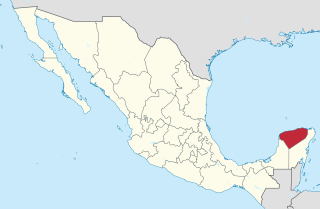
Yucatán, officially the Free and Sovereign State of Yucatán, is one of the 31 states which comprise the federal entities of Mexico. It is divided into 106 municipalities, and its capital city is Mérida.
The Huastec or Téenek are an indigenous people of Mexico, living in the La Huasteca region including the states of Hidalgo, Veracruz, San Luis Potosí and Tamaulipas concentrated along the route of the Pánuco River and along the coast of the Gulf of Mexico.

The Mayan languages form a language family spoken in Mesoamerica, both in the south of Mexico and northern Central America. Mayan languages are spoken by at least 6 million Maya people, primarily in Guatemala, Mexico, Belize, El Salvador and Honduras. In 1996, Guatemala formally recognized 21 Mayan languages by name, and Mexico recognizes eight within its territory.

The Maya peoples are an ethnolinguistic group of indigenous peoples of Mesoamerica. The ancient Maya civilization was formed by members of this group, and today's Maya are generally descended from people who lived within that historical civilization. Today they inhabit southern Mexico, Guatemala, Belize, El Salvador and Honduras. "Maya" is a modern collective term for the peoples of the region, however, the term was not historically used by the indigenous populations themselves. There was no common sense of identity or political unity among the distinct populations, societies and ethnic groups because they each had their own particular traditions, cultures and historical identity.

Classic Maya is the oldest historically attested member of the Maya linguistic family. It is the main language documented in the pre-Columbian inscriptions of the classical period of the Maya civilization. It is also a direct descendant of Proto-Mayan and the common ancestor of the Cholan branch of Mayan languages. Contemporary descendants of classical Maya include Ch'ol and Ch'orti'. Speakers of these languages can understand many Classic Mayan words.

The Madrid Codex is one of three surviving pre-Columbian Maya books dating to the Postclassic period of Mesoamerican chronology. A fourth codex, named the Grolier Codex, was discovered in 1965. The Madrid Codex is held by the Museo de América in Madrid and is considered to be the most important piece in its collection. However, the original is not on display due to its fragility; an accurate reproduction is displayed in its stead. At one point in time the codex was split into two pieces, given the names "Codex Troano" and "Codex Cortesianus". In the 1880s, Leon de Rosny, an ethnologist, realised that the two pieces belonged together, and helped combine them into a single text. This text was subsequently brought to Madrid, and given the name "Madrid Codex", which remains its most common name today.

Mesoamerican languages are the languages indigenous to the Mesoamerican cultural area, which covers southern Mexico, all of Guatemala and Belize and parts of Honduras and El Salvador and Nicaragua. The area is characterized by extensive linguistic diversity containing several hundred different languages and seven major language families. Mesoamerica is also an area of high linguistic diffusion in that long-term interaction among speakers of different languages through several millennia has resulted in the convergence of certain linguistic traits across disparate language families. The Mesoamerican sprachbund is commonly referred to as the Mesoamerican Linguistic Area.
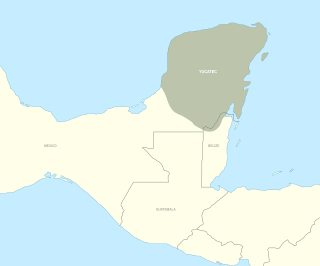
Yucatec Maya (; referred to by its speakers simply as Maya or as màaya t’àan, is one of the 32 Mayan languages of the Mayan language family. Yucatec Maya is spoken in the Yucatán Peninsula and northern Belize. There is also a significant diasporic community of Yucatec Maya speakers in San Francisco, though most Mayan Americans are speakers of other Mayan languages from Guatemala and Chiapas.
The Chʼol are an indigenous people of Mexico, mainly in the northern Chiapas highlands in the state of Chiapas. As one of the Maya peoples, their indigenous language is from the Mayan language family, known also as Chʼol. According to the 2000 Census, there were 140,806 speakers of Chʼol in Chiapas, including 40,000 who were monolingual.
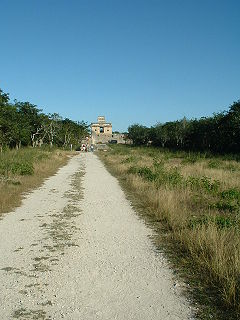
A sacbe, plural sacbeob, or "white way", is a raised paved road built by the Maya civilization of pre-Columbian Mesoamerica. Most connect temples, plazas, and groups of structures within ceremonial centers or cities, but some longer roads between cities are also known. The term "sacbe" is Yucatec Maya for "white road"; white perhaps because there is evidence that they were originally coated with limestone stucco or plaster, which was over a stone and rubble fill.

Apocalypto is a 2006 American epic historical adventure film produced, co-written, and directed by Mel Gibson. The film features a cast of Native American and Indigenous Mexican actors consisting of Rudy Youngblood, Raoul Trujillo, Mayra Sérbulo, Dalia Hernández, Gerardo Taracena, Rodolfo Palacios, Bernardo Ruiz Juarez, Ammel Rodrigo Mendoza, Ricardo Diaz Mendoza, and Israel Contreras. All of the indigenous people depicted in the film were Maya. Similar to Gibson's earlier film The Passion of the Christ, all dialogue is in a modern approximation of the ancient language of the setting. Here, the Indigenous Yucatec Mayan language is spoken with subtitles, which sometimes refer to the language as Mayan. This was the last film Gibson directed until 2016's Hacksaw Ridge ten years later.
Itzaʼ is a endangered Mayan language spoken by the Itza people near Lake Peten Itza in north-central Guatemala and neighboring Belize. The language has about 1,000 fluent speakers, all older adults.
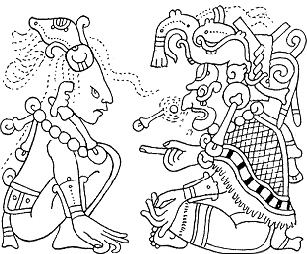
The traditional Maya or Mayan religion of the extant Maya peoples of Guatemala, Belize, western Honduras, and the Tabasco, Chiapas, Quintana Roo, Campeche and Yucatán states of Mexico is part of the wider frame of Mesoamerican religion. As is the case with many other contemporary Mesoamerican religions, it results from centuries of symbiosis with Roman Catholicism. When its pre-Hispanic antecedents are taken into account, however, traditional Maya religion has already existed for more than two and a half millennia as a recognizably distinct phenomenon. Before the advent of Christianity, it was spread over many indigenous kingdoms, all with their own local traditions. Today, it coexists and interacts with pan-Mayan syncretism, the 're-invention of tradition' by the Pan-Maya movement, and Christianity in its various denominations.
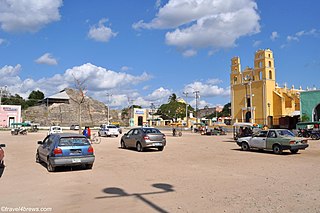
Acanceh is a town and ancient Maya archaeological site located in Mexico's Yucatán State, 21 kilometers from Mérida, the capital of Yucatán. It is the seat of Acanceh Municipality. The modern town of Acanceh, is partially atop the pre-Columbian site, and occupation seems to have been continuous. Acanceh means "groan of the deer" in the Yucatec Maya language.

The role of the children in ancient Mayan civilization was first and foremost to help their elders. Once children turned five or six they were expected to contribute to the family and community. They were treated as young adults and received more responsibilities as they grew older.
Maya textiles (k’apak) are the clothing and other textile arts of the Maya peoples, indigenous peoples of the Yucatán Peninsula in Mexico, Guatemala, Honduras, El Salvador and Belize. Women have traditionally created textiles in Maya society, and textiles were a significant form of ancient Maya art and religious beliefs. They were considered a prestige good that would distinguish the commoners from the elite. According to Brumfiel, some of the earliest weaving found in Mesoamerica can date back to around 1000-800 B.C.E.
Guatemalan Sign Language or "Lengua de Señas de Guatemala" is the proposed national deaf sign language of Guatemala, formerly equated by most users and most literature equates with the sign language known by the acronymic abbreviations LENSEGUA, Lensegua, and LenSeGua. Recent legal initiatives have sought to define the term more inclusively, so that it encompasses all the distinctive sign languages and sign systems native to the country.

Nikolai Grube is a German epigrapher. He was born in Bonn in 1962. Grube entered the University of Hamburg in 1982 and graduated in 1985. His doctoral thesis was published at the same university in 1990. After he received his doctorate, Grube moved to the University of Bonn. Nikolai Grube has been heavily involved in the decipherment of the Maya hieroglyphic script.
A village sign language, or village sign, also known as a shared sign language, is a local indigenous sign language used by both deaf and hearing in an area with a high incidence of congenital deafness. Meir et al. define a village sign language as one which "arise[s] in an existing, relatively insular community into which a number of deaf children are born." The term "rural sign language" refers to almost the same concept. In many cases, the sign language is known throughout the community by a large portion of the hearing population. These languages generally include signs derived from gestures used by the hearing population, so that neighboring village sign languages may be lexically similar without being actually related, due to local similarities in cultural gestures which preceded the sign languages. Most village sign languages are endangered due to the spread of formal education for the deaf, which use or generate deaf-community sign languages, such as a national or foreign sign language.
VictoriaReiflerBricker is an American anthropologist, ethnographer and linguist, widely known for her ground-breaking studies of contemporary and historical Maya culture.










